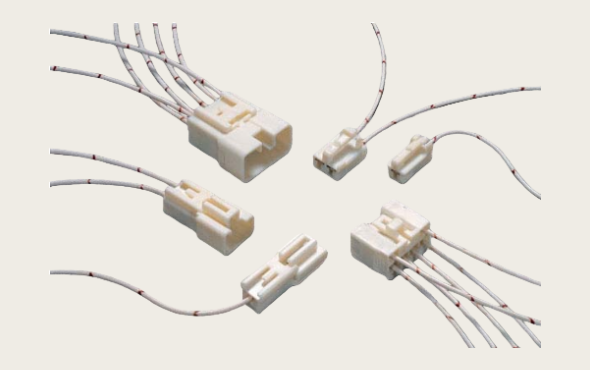In systems such as automotive, power, and rail transit, connectors are not only transmission channels for signals and currents but also important components for structure, shielding, waterproofing, and vibration resistance. Taking the well-known brand Yazaki as an example, its connectors are widely used in automotive-grade applications, and their specifications also mention related technical characteristics such as "corrosion resistance, oxidation resistance, and vibration resistance."
Then, when we observe the phenomenon of "the housing or terminal turning green" in domestic connectors ("replacement" models): what is actually happening? This article discusses its causes, effects, treatment, and prevention.

What is the "greening" phenomenon?“Greening” in connector structures usually refers to the appearance of green or bluish-green deposits or oxide layers on the surface of metal components (terminals, shells, shielding covers, etc.). Common manifestations include:
A light green coating appears on copper or copper alloy terminals (commonly found on brass and bronze parts)
● Rust or film peeling at the edge of metal casing or shielding cover
Contact resistance increases after insertion and removal, the shell seal fails, or there are damp traces.
From the perspective of the corrosion mechanism of electronic connectors, this phenomenon belongs to one of "electrochemical corrosion" or "chemical corrosion." When metal, oxygen, moisture/electrolyte interact together, an oxide, carbonate, chloride, etc., coating is formed, which is green or bluish-green.

Why do domestic connectors appear in this phenomenon? Analyze from the perspective of Yazaki brand and substitutes.Inadequate terminal material or coating selection
Yazaki mentioned in its environmental report "the development of corrosion-resistant technology for aluminum conductors and copper alloy terminals."
If the domestic alternative model does not strictly control the terminal material, plating thickness, and adhesion, it is more prone to oxidation, discoloration, and greenish formation in humid, salt fog, and thermal cycle environments.
Insufficient sealing performance, moisture/pollutants entering
Connectors that are not sealed properly allow moisture, water, and salt mist to enter the interior, forming an electrolytic environment that promotes the formation of an oxide film on the metal surface, resulting in green deposits. This is commonly seen on the undercarriage of actual vehicles and in engine compartments.
3. Excessive environmental stress / thermal fatigue
In automotive applications, connectors will experience temperature cycles from -40 ℃ to +125 ℃. If the design or process does not meet the standard (such as large thermal expansion differences between the shell and the sealing parts, and the generation of coating cracks), it will lead to micro-cracks on the metal surface, moisture penetration, and oxidation of the terminals, forming a green layer.
4. Impurities or electrochemical corrosion effects
If there are residues of chlorides, sulfides, salt mist, and other pollutants in the production and assembly process, or if different metals come into contact to form micro-batteries, corrosion may also be accelerated. Typical research on the corrosion of electronic connectors indicates that reducing the entry of moisture and lowering ion pollution are important means to control connector corrosion.
5. Cost/Process compromises in domestic alternatives
During the process of promoting the localization of connectors, in order to reduce costs, some manufacturers may make compromises in the coating thickness, anti-corrosion materials, and sealing technology. When they are applied in high humidity, high temperature, and strong vibration environments, problems such as "turning green," poor contact, and early failure are likely to be exposed.

What potential hazards can greenness bring?●Increase in contact resistance: The green oxide film has high resistance, which may cause signal attenuation, current drop, and heat increase.
●Mechanical locking weakening: If the housing or shield cover deforms or loses elasticity due to corrosion, the clips and locking mechanism may become loose.
●Waterproof/dustproof performance degradation: Moisture intrusion means seal failure, further accelerating the corrosion of internal metal parts.
● Decreased long-term lifespan: Connector design lifespan and reliability indicators (such as thermal cycling, salt mist testing) may not meet standards, leading to premature failure.
●System safety hazards: In the fields of automobiles, new energy, and rail transit, connector failures may cause system shutdown or safety accidents.

If the domestic connector turns green, what should be done? The following treatment suggestions are as follows:1. Immediate suspension of the assessment
Check whether this connector is still on the critical path, and whether there are any abnormal heat, poor contact, loose, or leakage stains. If the impact is severe, replace the entire component.
Clean the oxide layer and retest
Use an appropriate cleaner (a neutral cleaning solution for non-corrosive metals) and a soft brush to remove the green oxide film, avoiding further damage to the coating. After cleaning, measure the contact resistance, insulation resistance, and withstand voltage.
3. Evaluate Sealing and Structure
Check for loosening, cracks, or deformation of the sealing ring, housing interface, and clip structure. If the seal fails, replace the sealing part or the entire part.
4. More superior version with different material or coating
If it is a batch part issue, it is recommended to choose a version with more corrosion-resistant material (such as gold plated, silver plated, or using corrosion-resistant alloys), and increase the coating thickness or replace with a better corrosion prevention process.
Strengthening prevention and control
In the choice of domestic alternatives, it is explicitly required: terminal coating thickness, adhesion index; shell waterproof grade (such as IP67/IP6K9K); establish acceptance and testing standards for humidity, salt spray, and thermal cycle. Establish supplier process audit and on-site assembly protection procedures.
Establish a tracking and feedback mechanism
Establish records for connector batches that have already turned green, including the usage environment, installation location, exposure time, and maintenance status. This is for future design improvements or supplier audits.

"Connection terminals turning green" appears to be a "visual" phenomenon, but it is actually a signal of a reliability隐患. Taking international brands such as Yazaki as a reference, they have a mature system in terms of corrosion resistance, vibration resistance, and aging resistance. During the replacement process of domestic connectors, if they cannot catch up with the benchmark in terms of terminal material, plating technology, structural sealing, and moisture-proof design, it is very easy to encounter problems such as turning green, poor contact, and reduced lifespan in high humidity, high temperature, and vibration environments. Only by controlling the whole process from design, production, inspection, assembly, and maintenance can the "domestic replacement" truly be not just a change of brand, but "replacing for greater reliability and durability."
If you are interested in the domestic substitute products for Yazaki brand connectors or have procurement needs, or if you have production or sales channels for these brand connector domestic substitutes and wish to engage in in-depth cooperation or communication, please contact via the following contact information:
Manager Zhang (18665383950, same WeChat number)Contact us, we look forward to working together with more industry partners.




